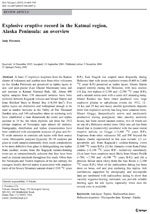Kaguyak Lower Ash Rib
Start: 5265 yBP ± 95 Years [1]
Event Type: Explosive
- Tephrafall [1]
Description: From Fierstein (2007): "The lower tephra ([sample] K-2500G) is 1 to 1.5-cm-thick and very fine-grained (Md=0.07 mm) in [the] Angle Creek section, but apparently thickens eastward to 3 cm on top of the Martin coulees (K-2661A; Fig. 3 [in original text]), where it is also a little coarser-grained (Md=0.12 mm). The glass is compositionally distinct from all other analyzed Martin and Mageik tephras (higher CaO/SiO2 and lower K2O/SiO2), and all major-element glass data plot in a coherent group that suggests affinity with the Kaguyak marker ash (Fig. 13a [in original text]). Additionally, the lower ash rib in Angle Creek is in the same stratigraphic position as that of the Kaguyak ash in the VTTS area. Magnetite data, however, preclude correlation between the two. Magnetite analyses yield a range of MgO (from 2.4-4 wt.% in K-2500G to 1.4-2.2 wt.% in K-2661A) and a range of TiO2 (10-14 wt.%) that is more similar to that of the upper grey ash (from Peulik) than to the tightly grouped data and the ∼8 wt.% TiO2 characteristic of the Kaguyak co-ignimbrite ash. This distinctive combination of glass and magnetite compositions has helped identify the "lower ash rib" at several locations in Angle Creek and suggests correlation with one of two fine-grained centimeter-thick pale orange tephras in the Griggs Fork ∼25 km ENE. Glass compositions ([samples] K-2440, K-2441, Fig. 13 [in original text]) and ilmenite data (not shown) for both samples at this location are consistent with lower ash rib and Kaguyak ash, but no magnetite has been analyzed so the compositional distinction between them is uncertain. However, radiocarbon dates on soil beneath the "lower ash rib" in Angle Creek are 5,265+/-95 and 5,160+/-160 14C years B.P. (sections K-2500 and K-2661, respectively), suggesting it is about 500 years younger than the Kaguyak co-ignimbrite ash."
"Although the data are inconclusive, several considerations suggest that this "lower ash rib" had a source at Kaguyak and is closely related to the caldera-forming eruption because: (1) Glass data are most similar to the Kaguyak ash and are dissimilar to tephra from the other Katmai volcanoes and from Peulik; (2) the "lower ash rib" is in a similar stratigraphic position in Angle Creek as the Kaguyak ash is in the lower VTTS; (3) apparent intimate mixing of the lower ash rib and Kaguyak tephras in one location in the lower VTTS suggest they were deposited closely in time; and (4) the tephra is everywhere fine grained, consistent with it being a distal ash from a nonlocal source. That the thickest ash measured is near the headwaters of Angle Creek may only be an artifact of preservation."
"Strongly contrary to the above are the wide ranges of magnetite compositions that are unlike those from ash and pumice related to the Kaguyak caldera-forming ignimbrite. Additionally, that the thickest preserved ash measured is in upper Angle Creek may reflect proximity to source and not be an artifact of preservation; pumice granules there are up to 5 mm across (although they are Frisbee-shaped with a low aspect ratio); and the median grain size is somewhat coarser than that a few kilometers westward (Table 1 [in original tex]). The Katmai volcanoes are well enough characterized that it seems unlikely this ash-with such distinctive glass compositions-came from Mounts Mageik, Katmai, or Griggs. No glass compositions similar to this ash have been found from Mount Martin, either, although the oxide data from this and the salt and pepper ashes are very similar. Some other non-local source seems most possible, whether Peulik, Kaguyak, or another Aleutian arc volcano that has had silicic Holocene activity."
"Although the data are inconclusive, several considerations suggest that this "lower ash rib" had a source at Kaguyak and is closely related to the caldera-forming eruption because: (1) Glass data are most similar to the Kaguyak ash and are dissimilar to tephra from the other Katmai volcanoes and from Peulik; (2) the "lower ash rib" is in a similar stratigraphic position in Angle Creek as the Kaguyak ash is in the lower VTTS; (3) apparent intimate mixing of the lower ash rib and Kaguyak tephras in one location in the lower VTTS suggest they were deposited closely in time; and (4) the tephra is everywhere fine grained, consistent with it being a distal ash from a nonlocal source. That the thickest ash measured is near the headwaters of Angle Creek may only be an artifact of preservation."
"Strongly contrary to the above are the wide ranges of magnetite compositions that are unlike those from ash and pumice related to the Kaguyak caldera-forming ignimbrite. Additionally, that the thickest preserved ash measured is in upper Angle Creek may reflect proximity to source and not be an artifact of preservation; pumice granules there are up to 5 mm across (although they are Frisbee-shaped with a low aspect ratio); and the median grain size is somewhat coarser than that a few kilometers westward (Table 1 [in original tex]). The Katmai volcanoes are well enough characterized that it seems unlikely this ash-with such distinctive glass compositions-came from Mounts Mageik, Katmai, or Griggs. No glass compositions similar to this ash have been found from Mount Martin, either, although the oxide data from this and the salt and pepper ashes are very similar. Some other non-local source seems most possible, whether Peulik, Kaguyak, or another Aleutian arc volcano that has had silicic Holocene activity."
References Cited
[1] Explosive eruptive record in the Katmai region, Alaska Peninsula: an overview, 2007
Fierstein, Judy, 2007, Explosive eruptive record in the Katmai region, Alaska Peninsula: an overview: Bulletin of Volcanology, v. 69, n. 5, p. 469-509, doi:10.1007/s00445-006-0097-y.Complete Eruption References
Explosive eruptive record in the Katmai region, Alaska Peninsula: an overview, 2007
Fierstein, Judy, 2007, Explosive eruptive record in the Katmai region, Alaska Peninsula: an overview: Bulletin of Volcanology, v. 69, n. 5, p. 469-509, doi:10.1007/s00445-006-0097-y.
